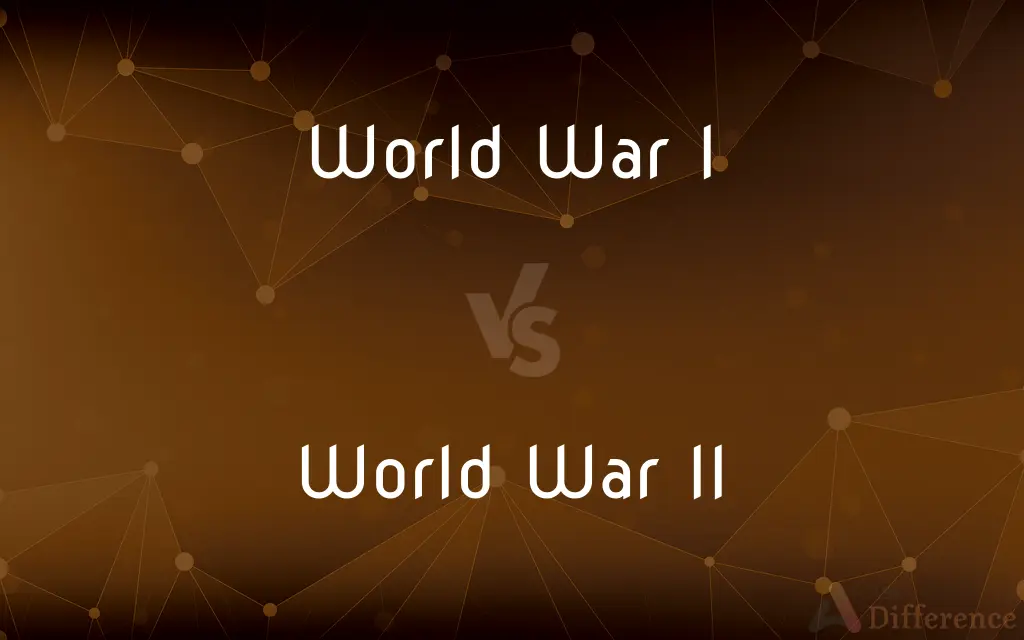World War I vs. World War II — What's the Difference?
By Tayyaba Rehman & Urooj Arif — Published on February 8, 2024
World War I (1914-1918) was a global conflict driven by nationalism and alliances, while World War II (1939-1945) was marked by ideological struggles, genocide, and atomic warfare.

Difference Between World War I and World War II
Table of Contents
ADVERTISEMENT
Key Differences
World War I, often termed the Great War, was a cataclysmic event that reshaped global politics and society, mainly fueled by nationalism, militarism, and a complex web of alliances. Conversely, World War II, ensuing just two decades later, was predominantly characterized by ideological conflicts, with fascism, Nazism, and imperialism clashing against democracy and communism. While both wars had profound global impacts, their underlying causes and the nature of warfare were distinctively different.
The warfare tactics in World War I revolved around trench warfare and attritional strategies, often resulting in stalemates and massive losses, a stark contrast to the rapid, mobile warfare, or "Blitzkrieg," that defined the early years of World War II. Moreover, World War II was distinguished by significant technological advancements, including the use of aircraft, tanks, and, ultimately, the atomic bomb, a leap from the relatively primitive weaponry of World War I.
World War I's conclusion saw the dismantling of empires and the formation of new nations, guided by the Treaty of Versailles, which also laid punitive conditions on Germany. In contrast, the aftermath of World War II was marked by the onset of the Cold War, the division of territories into spheres of influence by the victorious powers, and the establishment of the United Nations aimed at preventing future conflicts, reflecting the distinct geopolitical landscapes post each war.
The societal impact of World War I was profound, leading to a lost generation and a sense of disillusionment reflected in the cultural and artistic expressions of the time. World War II, however, brought about unprecedented destruction, including the Holocaust and atomic bombings, deeply scarring the global conscience and reshaping international relations and ethical considerations in warfare.
While World War I was a turning point in warfare, introducing deadly weapons and tactics, it was World War II that truly globalized conflict, involving nearly every part of the world and introducing a new era of nuclear capabilities. Both wars, despite their differences, marked significant shifts in global power structures, ideologies, and the nature of international conflict.
ADVERTISEMENT
Comparison Chart
Timeframe
1914-1918
1939-1945
Abbreviation
WWI
WWII
Global Impact
Ended with the reshaping of European borders and colonies
Resulted in the creation of the United Nations and the onset of the Cold War
Technological Advancements
Introduction of tanks, machine guns, and chemical warfare
Advancements in nuclear weapons, radar, and aircraft
Literary Representations
Often depicted as a tragic, futile conflict
Frequently portrayed as a battle against tyranny and genocide
Compare with Definitions
World War I
World War I was a manifestation of complex alliances and burgeoning nationalisms.
The intricate alliance system was one of the main factors that escalated a regional conflict into World War I.
World War II
World War II led to significant geopolitical shifts and the establishment of the United Nations.
The conclusion of World War II marked the beginning of the Cold War and a new era in international politics.
World War I
World War I was a global military conflict originating in Europe, characterized by trench warfare and massive casualties.
The assassination of Archduke Franz Ferdinand is often cited as the spark that ignited World War I.
World War II
World War II had a profound impact on culture, economy, and the global order.
The post-World War II era saw significant economic growth and the rise of consumer culture in many parts of the world.
World War I
World War I marked the end of the old world order and the beginning of a new era in international relations.
The consequences of World War I were far-reaching, shaping the geopolitical landscape of the 20th century.
World War II
World War II was characterized by rapid technological advancements and total war strategies.
The use of blitzkrieg tactics by Germany revolutionized warfare during World War II.
World War I
World War I is often remembered for the unprecedented scale of suffering and the introduction of new, more deadly weapons.
The use of chemical weapons during World War I marked a dark chapter in military history.
World War II
World War II was a global conflict marked by the ideological clash between the Axis and Allied powers.
The invasion of Poland by Nazi Germany in 1939 is widely considered the beginning of World War II.
World War I
World War I catalyzed significant social, political, and technological changes.
Women took on new roles in society during World War I, working in factories and serving in auxiliary military positions.
World War II
World War II witnessed the horrors of the Holocaust and the introduction of nuclear warfare.
The devastating consequences of the atomic bombings of Hiroshima and Nagasaki brought World War II to a grim end.
Common Curiosities
What were the outcomes of World War I and World War II?
World War I led to the redrawing of borders and punitive measures against the Central Powers, while World War II resulted in the establishment of the United Nations, division of territories, and the onset of the Cold War.
How did the warfare tactics in World War I and World War II differ?
World War I was characterized by trench warfare and attrition, whereas World War II saw rapid, mobile warfare (Blitzkrieg) and significant technological advancements.
How did World War I and World War II affect the global economy?
Both wars disrupted global economies, but World War II, in particular, led to significant economic shifts, setting the stage for post-war recovery and growth, especially in the US and Western Europe.
How are World War I and World War II remembered in history?
World War I is often remembered for the loss of a generation and the failure of peacekeeping mechanisms, while World War II is remembered for its ideological conflicts, the Holocaust, and the atomic bombings.
How did World War I and World War II reshape international relations?
World War I led to the League of Nations and reconfiguration of empires, while World War II resulted in the formation of the United Nations and the emergence of the US and USSR as superpowers.
What were the humanitarian impacts of World War I and World War II?
Both wars led to immense human suffering and loss of life. World War II, in particular, witnessed atrocities like the Holocaust and the widespread impact of atomic bombings.
How did World War I and World War II affect women and minorities?
Both wars led to increased participation of women in the workforce and military. World War II, in particular, led to significant movements for civil rights and recognition of minorities' contributions.
What caused World War I and World War II?
World War I was primarily caused by nationalism, militarism, and complex alliances, while World War II was triggered by unresolved issues from WWI, aggressive expansionist policies of Axis powers, and ideological conflicts.
What were the cultural impacts of World War I and World War II?
Both wars significantly influenced arts and literature, with World War I leading to disillusionment and modernism, while World War II's impact ranged from reflections on human rights to the celebration of heroism.
What lessons were learned from World War I and World War II?
The wars taught the importance of effective conflict resolution, the dangers of extreme nationalism and ideologies, and the need for international cooperation to maintain peace.
How did World War I and World War II change the concept of warfare?
Both wars revolutionized warfare, with World War I introducing trench warfare and World War II advancing in terms of mobility, strategy, and technology.
What role did technology play in World War I and World War II?
Technological advancements played critical roles in both wars, with World War I introducing tanks and chemical weapons, and World War II seeing the development of radar, jet engines, and nuclear weapons.
How did alliances impact World War I and World War II?
In World War I, a complex web of alliances escalated a regional conflict into a global war. In World War II, alliances were crucial in forming the Axis and Allied powers, determining the war's course.
How did World War I and World War II influence global governance?
World War I led to the creation of the League of Nations, while World War II resulted in the establishment of the United Nations, both aimed at promoting peace and cooperation among nations.
What were the main differences in the post-war treaties of World War I and World War II?
Post-World War I treaties, like the Treaty of Versailles, were punitive and laid the groundwork for future conflicts. Post-World War II arrangements aimed at establishing a lasting peace and rebuilding war-torn regions.
Share Your Discovery

Previous Comparison
Intel i3 vs. Intel i5
Next Comparison
Paperback vs. Mass-Market PaperbackAuthor Spotlight
Written by
Tayyaba RehmanTayyaba Rehman is a distinguished writer, currently serving as a primary contributor to askdifference.com. As a researcher in semantics and etymology, Tayyaba's passion for the complexity of languages and their distinctions has found a perfect home on the platform. Tayyaba delves into the intricacies of language, distinguishing between commonly confused words and phrases, thereby providing clarity for readers worldwide.
Co-written by
Urooj ArifUrooj is a skilled content writer at Ask Difference, known for her exceptional ability to simplify complex topics into engaging and informative content. With a passion for research and a flair for clear, concise writing, she consistently delivers articles that resonate with our diverse audience.
















































